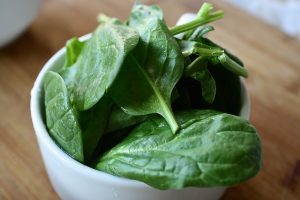- Spinach is one of those crops that has year-long availability. It is rich in vitamin A and C and is relatively free of problems.

Spinach originally came from the Middle East and yet given the arid conditions it comes from, it is most at home in the cool and wet climate of Northern Europe. Indeed it can be too comfortable given its propensity for growing out of control. In the good old days, spinach was grown to its full maturity but nowadays it is used as a baby spinach for salads and stir-fries.
Spinach likes some sun and partial shade but not full shade. Avoid the sunniest spots as hot weather causes bolting. It likes moisture retentive, fertile soil so digging in plenty of well-rotted organic manure or other organic matter. Add this a few weeks prior to planting provides the perfect foundation for strong and healthy plants.
Sowing Spinach Seeds
If you want plants to grow to full maturity. Sow your seeds in drills 2.5cm (1in.) deep and 30cm (12in.) apart. When the seedlings emerge, thin out so that plants are 15cm (6in.) apart. Sow the Summer varieties as early as mid-February under cloches or fleece. Any other time – March to May for Autumn and early Winter. The Winter varieties are sown the same way in August to September.
Young plants need protection when the weather is cold so cloche up or cover with fleece. Allow them to get firmly established.
Growing On
Once spinach is growing you can leave to get on with growing as they do not need much attention. Just make sure to weed regularly as spinach is prone to being out-competed by other plants. Just keep the spinach bed well watered, it is easy for the bed to dry out so avoid at all costs. Add more water in really hot weather as it is a bit like a weed in its native environment. Keep a small light mulch around the plants so that moisture is retained.
If you want cut-and-come again baby leaf spinach, best grow in containers and feed with a high-nitrogen liquid feed on a regular basis.
Harvesting Spinach
Pick outer leaves as the plant matures or cut whole plants at the base for greater quantities. If spinach leaves are to be frozen, cut out any thick stalks than blanch the leaves by boiling them for a minute before plunging them into cold water. Harvest all the leaves throughout the year. Seal in polythene bags and pop them in the freezer.
Varieties:-
Amazon F1: Grow as a baby leaf or to full maturity. This dark green variety is slow to bolt and is downy mildew resistant.
Banjo: Has crinkled leaves. A variety referred to as a semi-savoy variety. Slow to bolt and highly resistant to mildew.
Comred: Has a dark red hue which is perfect as a baby leaf to add colour and highly resistant to mildew.
Emilia: The fastest growing variety. Good for baby leaf salads, slow to bolt and with good mildew resistance.
Giant Winter: The hardy winter variety of choice which produces large dark green leaves. Has a strong flavour, it is perfect for that winter casserole.
Trombone: A dark-green leaved and slow-growing variety that can be grown throughout the year and has good resistance to bolting. It is also fairly mildew resistant.
Please note this page contains links to our affiliate marketing partners. Please read our affiliate disclosure.
Leave a Reply